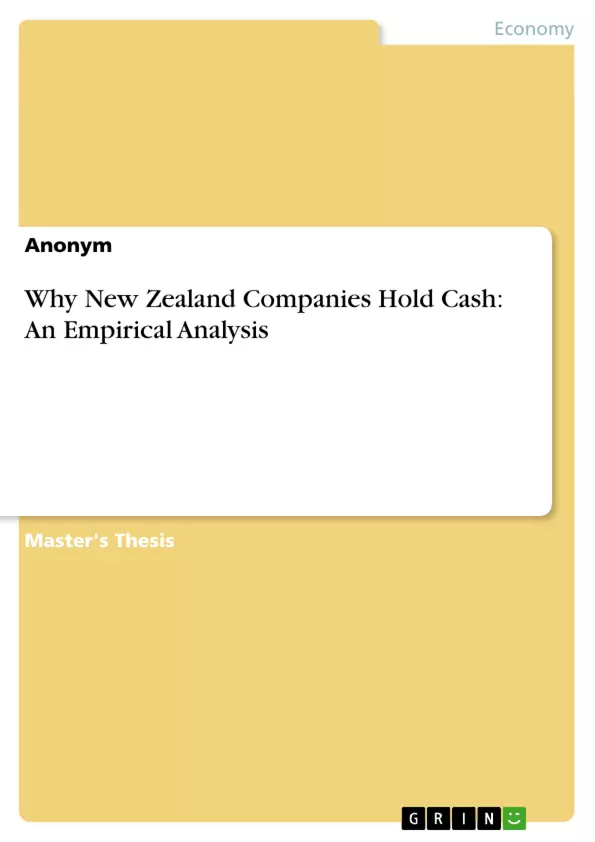As Ross, Westerfield and Jordan (2000) report, at the end of 1997 a number of US companies piled up tremendous amounts of cash and marketable securities. At that time Ford held US $20.8 billion, GM US $14.5 billion, and Chrysler US $7.1 billion in liquid assets. This naturally raises the question for which reasons a firm would hold such large amounts of cash, and if there is an optimal amount of cash holdings. While this issue remained largely unexamined in the financial literature for years, recently, some researchers tried to explore the determinants of corporate cash holdings in the US (e.g. Opler, Pinkowitz, Stulz and Williamson, 1999) and in some European countries (e.g. Ferreira and Vilela, 2002). However, different reasons for holding cash might exist in countries with less developed economies. In this study, I examine the determinants of corporate cash holdings using a sample of companies listed at the New Zealand Stock Exchange in the 1980-2003 period.
This work is guided by three theoretical models which are helpful in finding the determining factors of cash holdings. However, these models partially disagree about how certain firm characteristics affect liquid asset holdings. The trade-off model assumes that companies weight the marginal benefits and the marginal costs of holding cash to decide on their cash holdings. Thus, firms have a target cash level to which they continuously try to adjust. Benefits of holding cash are for example the reduction of transaction costs, and costs related to holding cash are mainly opportunity costs.
The second model of corporate cash holdings is the financing hierarchy model. Ac-cording to this theory, firms want to avoid costs induced by asymmetric information and, therefore, use cash from retained earnings to finance investments before using debt or even equity.
Inhaltsverzeichnis (Table of Contents)
- Introduction
- Theory of Corporate Cash Holdings
- Static Trade-Off Model
- Financing Hierarchy Model
- Free Cash Flow Model
- Additional Factors Influencing Corporate Cash Holdings
- Summary of Theoretical Models
- Review of Empirical Studies
- Data
- Data Description
- Variable Definitions
- Descriptive Statistics
- Statistical Background
- Introduction to Panel Data Models
- Regression Methodologies
- Fama-MacBeth Model
- Cross-Sectional Regression
- Time-Series Cross-Sectional Regression with Year Dummies
- Fixed-Effects Regression
- White Standard Errors
- Empirical Investigations
- Univariate Tests
- Determinants of Corporate Cash Holdings
- Basic Regressions on the Whole Data Sample
- Regression with Cash Flow Variability and 1/Z-Score
- Regression with Cash Flows from Cash Flow Statements
- Regression Tests for Managerial Discretion
- Investigation of Mean Reverting Characteristics
- The Use of Excess Cash
- Review of Current Literature on Excess Cash Holdings
- Empirical Investigation of Excess Cash Holdings
Zielsetzung und Themenschwerpunkte (Objectives and Key Themes)
This thesis aims to investigate the reasons behind the high cash holdings of New Zealand companies. It aims to provide an empirical analysis of the determinants of corporate cash holdings and the potential use of excess cash. This analysis is based on a sample of publicly listed New Zealand companies.
- Theoretical frameworks explaining corporate cash holdings
- Empirical analysis of determinants of corporate cash holdings in New Zealand
- Investigating the use of excess cash
- Exploring potential relationships between company characteristics and cash holdings
- Application of various statistical methodologies to analyze panel data
Zusammenfassung der Kapitel (Chapter Summaries)
Chapter 1 provides an introduction to the research topic, outlining the motivation and objectives of the study. Chapter 2 reviews the existing theoretical frameworks explaining corporate cash holdings, discussing various models such as the static trade-off model, the financing hierarchy model, and the free cash flow model. Chapter 3 presents a comprehensive review of relevant empirical studies on corporate cash holdings, highlighting key findings and methodologies. Chapter 4 details the data used in the empirical analysis, providing a description of the data sample, variable definitions, and descriptive statistics. Chapter 5 introduces the statistical background, outlining the different regression methodologies employed in the analysis, including panel data models and White standard errors. Chapter 6 presents the results of the empirical investigations, exploring the determinants of corporate cash holdings in New Zealand using various regression models. Chapter 7 investigates the use of excess cash, examining the relationship between excess cash holdings and investment behavior.
Schlüsselwörter (Keywords)
Corporate cash holdings, New Zealand companies, empirical analysis, determinants of cash holdings, excess cash, investment behavior, panel data models, regression methodologies, White standard errors.
- Arbeit zitieren
- Anonym (Autor:in), 2004, Why New Zealand Companies Hold Cash: An Empirical Analysis, München, GRIN Verlag, https://www.grin.com/document/23648



